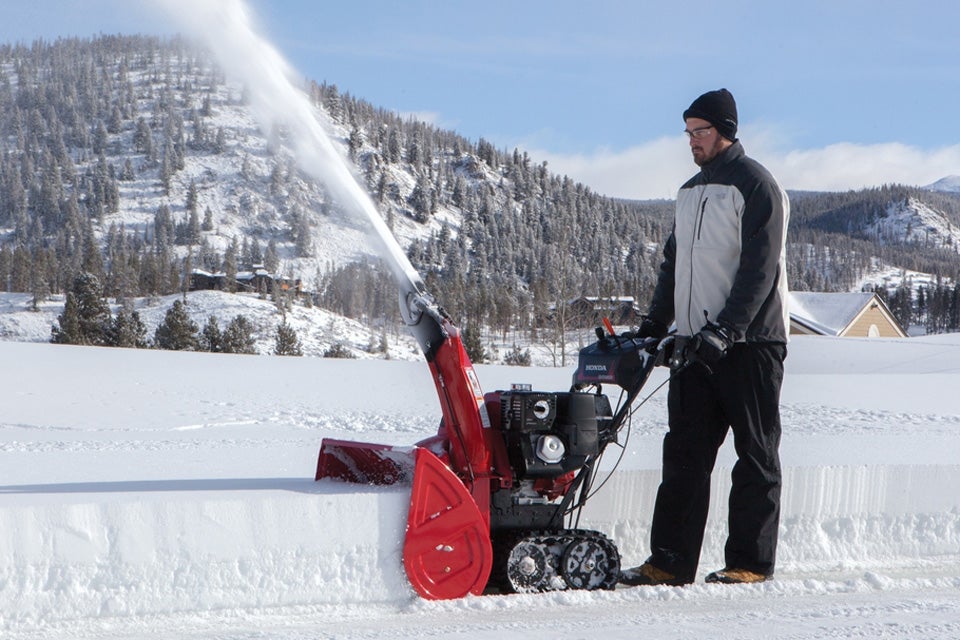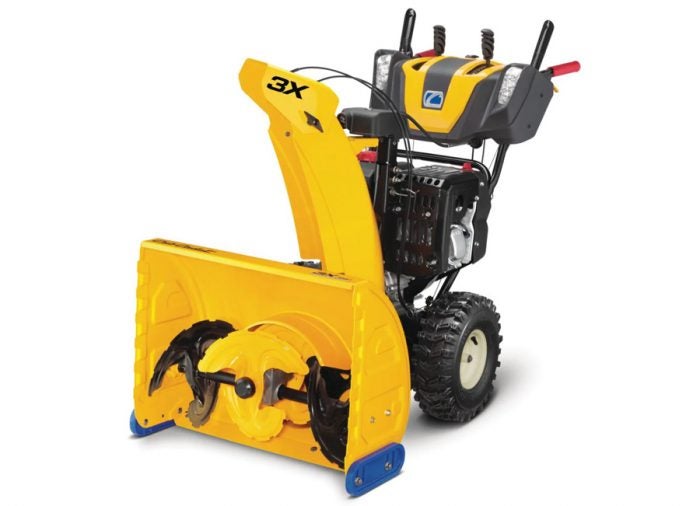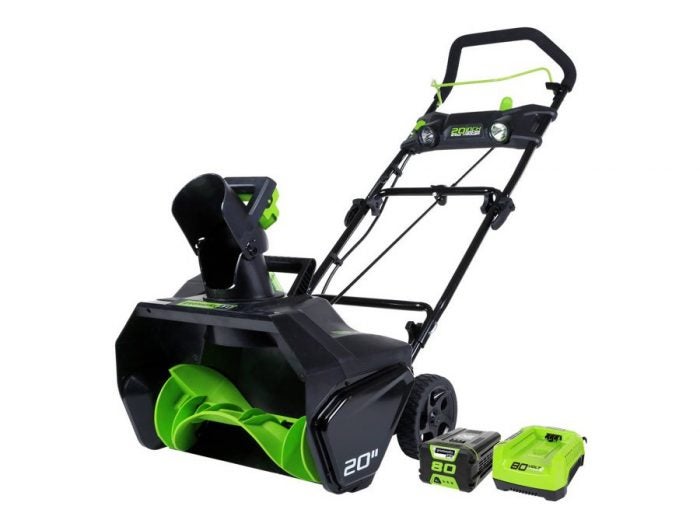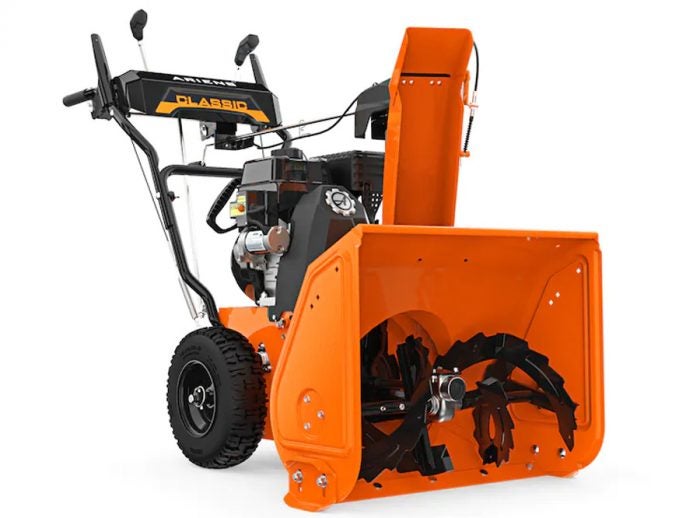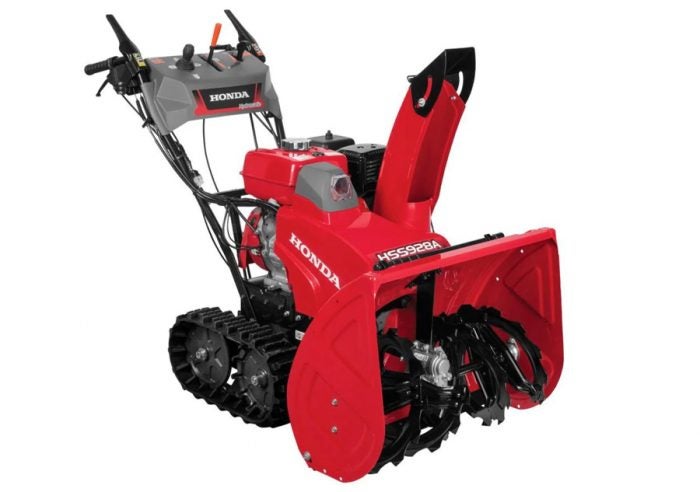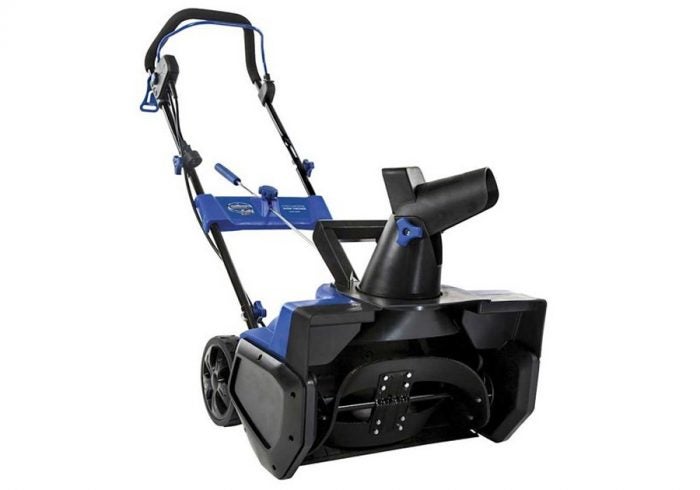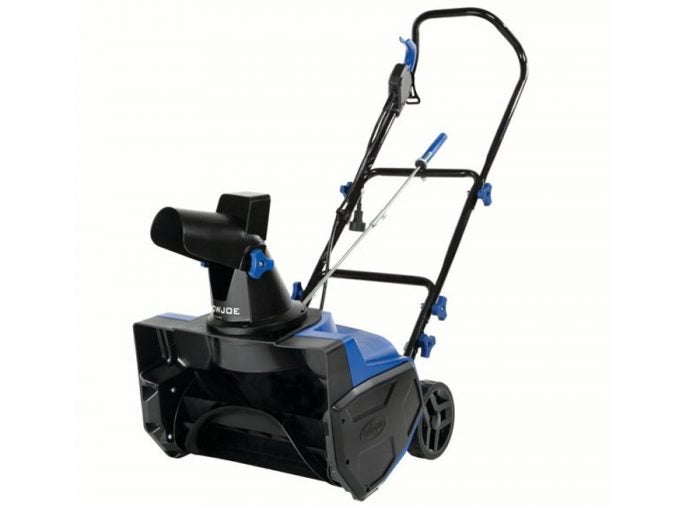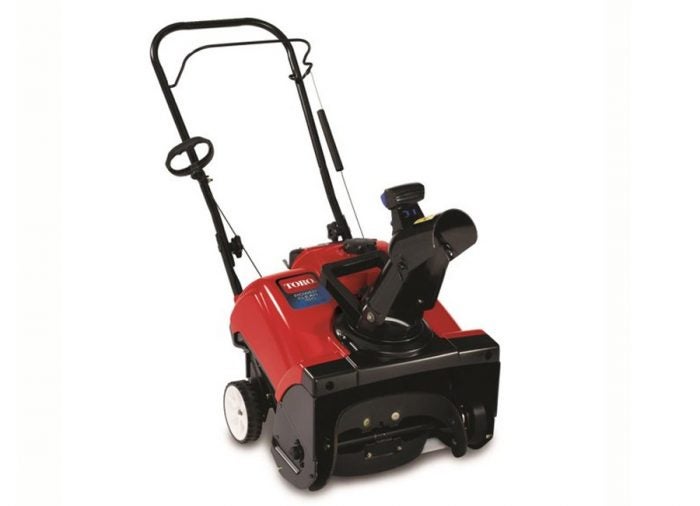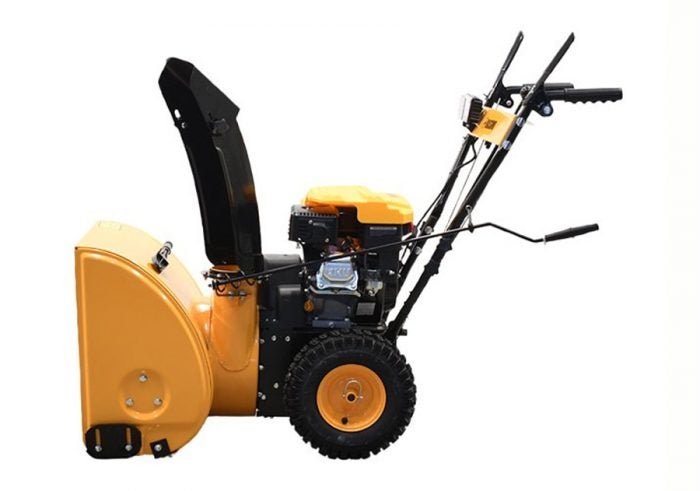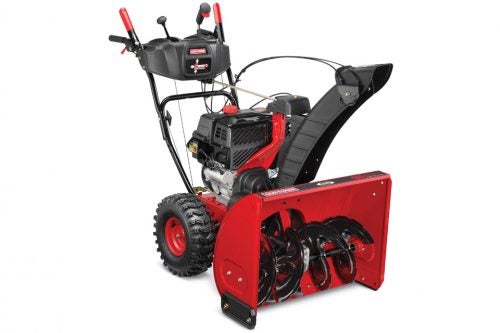With the better part of our nation currently gripped firmly in the tentacles of Old Man Winter, you may be wondering at what point it’ll finally be okay to stop shoveling the driveway. The quick answer? As soon as you decide to buy a snowblower. But what kind of snowblower do you need? What maintenance do they need, and what do you do when one frosty morning the snow stops blowing? We’re here to help you on your journey to finding the best snowblower for your needs.
Your author will cop to a former mindset of ‘shoveling snow is great exercise’ until several heavy dumps of the white stuff combined to result in this oversized human laying prostrate on his driveway wracked with exhaustion. Ok, maybe that’s a bit of an exaggeration, but there’s no doubt winter life has improved immensely since I purchased a snowblower.
Single-Stage vs. Two-Stage vs. Three-Stage Snowblowers
So what’s with all those stages? Glad you asked. Take a look at (but don’t touch!) those spinning auger blades up front. Single-stage blowers have one set of them to accomplish the task of both chopping up the snow and spitting it out the discharge chute.
It’s a lot of work for a single set of blades, so two-stage units have separately driven parts for each task, permitting better performance of both jobs. The main auger in the front chops, compacts and directs the snow to an impeller (the second stage) and that impeller handles the work of throwing the snow out of the chute, letting it throw further, even with heavy snow.
Mighty three-stagers deploy an auger that pulls snow away from the front blades and pushes it into the impeller that blows it out of the chute.
So which is the best snowblower type?
This depends on what you need as well as the amount and type of snow you get. Heavy snowfalls are best handled by a three-stage snowblower. One of these machines can cut through large snowbanks because their perpendicularly spinning augers do a great job of breaking down packed snow; imagine mashing potatoes with two forks instead of one and you’ve got the general idea. For most users, a two-stage snowblower saves money and will work just fine. Single-stagers are fine if you’re clearing the occasional snowfall that’s only two or three inches deep and isn’t full of ice or wet snow. They’re also handy on small drives or walkways, as long as you don’t let snow build up.
Electric Snowblowers
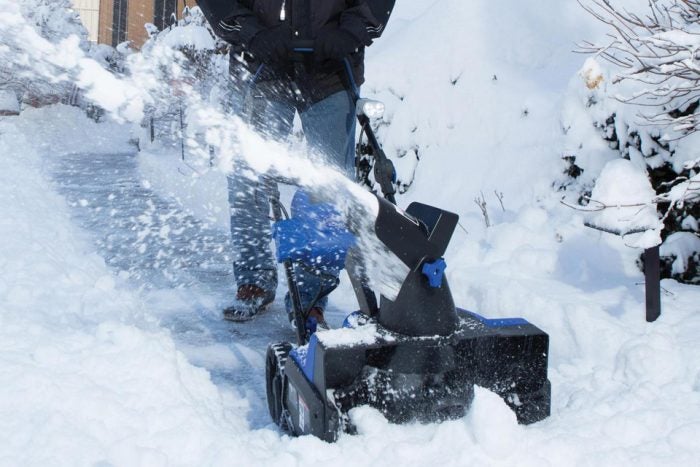
There’s no doubt that electric snowblowers (and throwers) are far better than they used to be. Only a few short years ago, they were relegated to the dustbin of interesting diversions for total cheapskates. These days, battery and electric motor technology has advanced to the point where an electric motor can be just as powerful as a gasoline one in the right conditions.
There are even two-stage battery-powered snow blowers on the market, letting you throw snow with some of the better gas-powered units. In their size class, at least, as these two-stage electrics aren’t offered in sizes as large as gas. If you’re considering a single-stage blower, an electric model is most certainly your best bet thanks to their near-zero maintenance requirements, making them almost as easy to own as a shovel.
Cordless electric blowers can now handle an average-sized driveway on a single charge, but check the specs carefully. You’re probably going to want to stick with a gas snowblower on a larger drive unless you don’t mind a break in the middle. If you’re looking at wet and heavy snow, you’ll either need to start early in the storm with an electric or stick with a big gas engine.
What Size Snowblower is Best?
Before you hand over your hard-earned money on a new snowblower, make sure you’ve enough space to store this thing. Seriously – even the smallest ones on this list take up a good chunk of room.
Ultimately, choosing the right size snowblower largely depends on the amount of snowfall you typically have in your area and how big of a space you need to clear. If you live in the middle of the snow belt and have a long and wide driveway to clear, it’s worth spending a bit more to get a snowblower that can clear a wider path. Something at least 30 inches wide would be wise and save you quite a few trips up the driveway and back. But if you just have a single-car driveway and some sidewalk to clear, a narrower snowblower (18-22 inches wide) is likely the better fit and will be easier to move around and find space for in your garage or shed. Narrower snowblowers are lighter, making them easier to maneuver, even if you have a model that can steer.
As for snowblower engine size, getting the biggest engine you can isn’t always the best choice. But if you regularly have to clear deep, heavy snow, a bigger engine sure can help make your life a little bit easier. More powerful engines are more capable, but they’re also heavier, more expensive and use more fuel.
How to Use a Snowblower
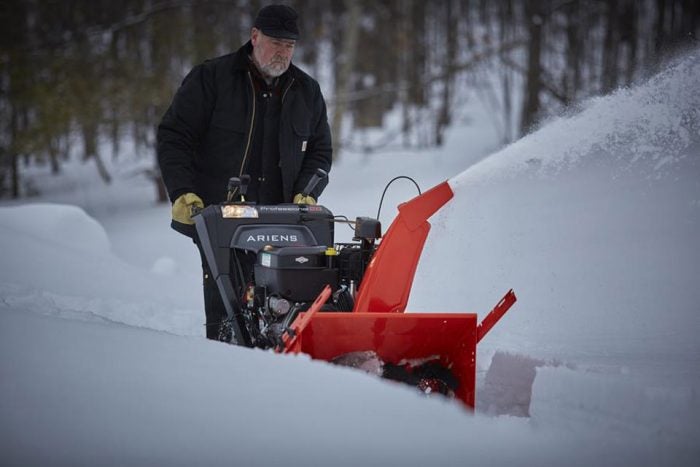
You’ve got the handy machine in your driveway, but how do you actually use it? Start ahead of the storm, making sure there is gasoline in the tank (we recommend using ethanol-free fuel and a fuel stabilizer at all times because modern fuel can gum up the engine in a hurry), oil in the sump, that your cordless battery is charged, or that you know where the good extension cord is. At the start of the season, fire your snowblower up long before the first storms to make sure everything is working well so you’re not turning wrenches in a blizzard.
We’re going to assume you’ve read your owner’s manual (yes, really!), because every snowblower uses slightly different controls and has a slightly different starting procedure. At least watch a YouTube video on how to run the thing, please.
Now it’s time to blow, you know, so out the garage door we go. Watch the wind first, if the wind is howling in one direction, don’t blow snow in that direction. Start upwind, aiming the chute downwind, and clear your driveway that way. If it’s not windy, start in the center and blow the snow to the nearest side.
Once the pavement is clear (and if there’s going to be a bigger dumping than your blower can handle, yes, you’re going to have to do some mid-storm clearing), then finish up the walkways and paths and be ready to re-do the end of the driveway as soon as the street plow drives by. Which will most likely be at about the same moment you sit down in a warm chair with some hot chocolate.
Once you’re done, let the machine run for a minute or two to make sure there’s no snow packed up inside. It’ll freeze and then good luck starting the machine next time. Top up the gas, throw the battery on the charger, coil up the extension cord, and go warm up.
Snowblower Repair
Even the best snowblower will need a minor repair now and again. For a thorough troubleshooting guide, check out our link here, but we’ll hit some of the highlights. If you’re having trouble starting, make sure the choke is on for a cold start, off if it’s already warmed up. Make sure the throttle is also in the start position.
If it still won’t fire, make sure you both have gas, and that it’s good gas. If it smells bad, or like varnish, you’ll need to flush the system. If the gas smells good, check the spark plug. Plug gap is important, but an old or dirty plug means rough starting and rougher running.
Air and fuel filters can also cause rough running and poor starting, as your snowblower can’t move enough of either to make power. Especially if it stalls under load, check your filters.
If you can’t get past these steps, it’s time to find your local small engine repair shop. Fortunately, there’s probably one in your neighbourhood. Unfortunately, they’re probably busy. If your snowblower is already on borrowed time, you might choose replace over repair, but we always recommend at least an estimate.
Snowblower Maintenance
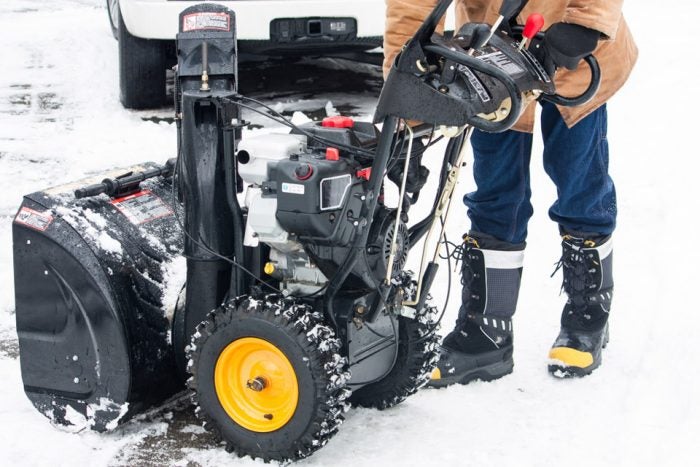
Snowblowers don’t need much in the way of maintenance, fortunately. New oil every year that matches the manual-recommended grade (with a change every 25 hours of running or so). Spark plugs can be cleaned and re-gapped, but since you’re doing an annual oil change anyway, replacing it yearly using commonly available kits that include fuel stabilizer, air filter, oil, and that plug is a great option.
Check your tire pressures or track tension, make sure that the scraper bar that sits under the snow hopper is intact, and wobble the auger (not when the engine is on!!) to make sure the bearings are tight. Check and replace the gearbox oil as required as well, if your unit has one.
You can skip most of this for electric machines, but tire pressures, scrapers, and bearings are still important.
Lastly, the shear pin. This is a small metal pin designed to protect your snowblower’s driveline. Hit snow that’s too dense or too full of ice and the pin, which goes between the auger blade and its inner driveshaft, snaps. It’s designed to let the driveline still rotate when the blades can’t, because stopping the entire driveline in an instant will do some serious damage. Shear pins will usually break at the worst time, so find out which pin yours uses and keep at least half a dozen on hand. They’re easy to pop in and out, because they’re designed as a safety mechanism. If yours snaps, once you’ve replaced it (engine off, of course), try and break up the pile that broke it with a shovel before tackling it again.
10 Best Snowblower Models
Below you’ll find 10 options for clearing that misery from your property in jig time. We tried to cover a variety of price points and snowblower styles so you can find the best snowblower for your needs.
Editor’s Choice: Cub Cadet 26-inch 357cc Three-Stage
We’re starting with the big guns because this machine is made to clear avalanche quantities of snow while making things as comfortable as possible for you. Its 26-inch intake makes quick work of a standard suburban driveway but isn’t overkill on narrower walkways and paths. Its impeller system is of a three-stage design, meaning it’ll chew up winter’s worst and spit it out the chute with ease. When we are looking for the best snowblower for those of us who deal with the deep stuff, this is what we need.
An electric start makes getting underway a simple task of pressing a button on the blower. Heated grips seem superfluous until you actually try them, and the twin headlights are perfect for those occasions when you have to clear snow in the dark. Special levers permit one wheel to spin for easier turning. Throw in a set of easy-to-use controls and a powerful 357cc engine with electric start to create a seriously capable snow clearing machine that won’t break the bank. Simply put, this just might be the best snowblower for you.
- Pros: Slices through snow, powerful engine, dandy features
- Cons: Large size takes up garage space
Buy Now
Troy-Bilt Storm Tracker 26-inch 208cc Two-Stage
It’s not the largest engine on this list at just 208cc, but it makes up for that with a seriously useful feature. This is an affordable snowblower that uses tracks instead of tires. These tracks offer much more traction than even chained-up tires, especially on ice and steep driveways. Push-button electric start means no pulling the cord and power steering lets you steer it (just like a tank) with just one finger.
The machine has 12-inch augers to cut up snow and a four-way electronic chute control to make sure you don’t need to fuss with mechanical controls to change the direction the snow is going. Heated hand grips keep your fingers toasty and a headlight makes sure you can see where you’re going.
- Pros: Attractive price, tracks, electric start
- Cons: 208cc’s means it’s a little undersized
Buy Now
Greenworks PRO 20-Inch 80V Cordless
Not all snowblowers need to operate with a noisy gasoline-powered engine. This machine is powered by a digitally-controlled brushless electric motor fed by an 80V battery – and yes, batteries are included. The manufacturer says that this will get you about 45 minutes of runtime before needing a charge, and we figure you’ll probably want to go in and warm up after that amount of time outdoors in the snow, anyway.
The single-stage auger clears a 20-inch swath of snow up to 10-inches deep, letting you clear your drive quickly and quietly. Its discharge chute rotates a full 180-degrees, allowing you to control the snow removal from side to side without stopping, and it will throw snow up to 20-feet. There is on-board lighting for nighttime and large rear wheels for easy maneuvering. This is one the shortlist for the best electric snowblower.
- Pros: No cords to accidentally destroy, positive reviews
- Cons: Owners must remember to charge that battery, only a 20-foot throw
Buy Now
Ariens Classic 24-inch 208cc Two-Stage
Ask any gearhead or brand snob who knows a thing or two about snowblowers and you can be guaranteed that Ariens will rank highly for just about anybody looking at the best snowblower brands. This is with good reason. Ariens makes a very reliable machine, one whose parts and pieces work well together to pitch snow clear on the other side of your property. These things are powerful and built to last.
This particular unit is propelled by a mid-range engine with 208cc of displacement. A two-stage impeller gets the job done up front while the likes of electric start and intuitive controls make for an easy time operating the thing. Intake size is 24 inches, meaning it can be wrangled out most residential doors, and it will throw snow up to 40 feet away.
- Pros: Excellent construction, powerful operation, bragging rights
- Cons: Not cheap based on specs
Buy Now
Honda 28-inch Track-Drive 270cc
Here’s one for the homeowner who also has a vintage Integra Type R in the garage and presses an all-wheel drive Pilot SUV into daily duty for the family. If the Ariens brand is well-regarded in this sphere, then Honda snowblowers have been elevated to something of a mythical status. Price aside, real-world customers rave about these machines, praising their power and reliability. Sounds a bit like Honda’s road-going vehicles, no?
This gasoline-powered unit has a 270cc engine, but it’s probably the meanest on the list. The controls are dead simple to use making operation a breeze. As with most machines from Honda, you’re paying for its engineering – unlike everything else here, this blower’s transmission is an infinitely variable hydrostatic unit instead of a geared box, providing the oomph to bulldoze through that snowbank despite a diminutive engine size with tracks to help ensure bulldozer-like traction to go with its snow-throwing power. Bottom line, Honda tops many people’s lists for the best snowblower brands for good reason. You could do a whole lot worse than this model. It even has electric control of the snow discharge chute.
- Pros: Well engineered, handy controls, robust construction
- Cons: Big price tag
Buy Now
Ego Power+ 56-volt 24-inch Two-Stage
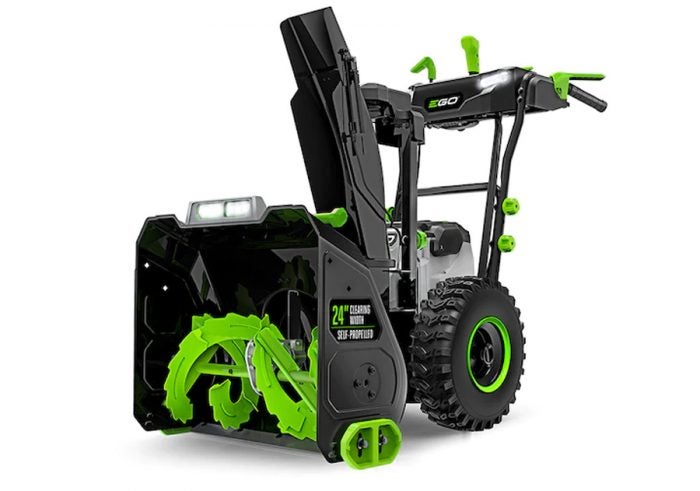
This is one of those modern two-stage electric snowblowers we mentioned earlier. It comes with a pair of 56V Ego Arc Lithium batteries that offer up enough power to clear eight-inches of snow from a 24-car driveway. A brushless motor adds electric efficiency and removes worries about long-term durability. Plus you can forget about messy seasonal oil changes and adding fuel stabilizer or cleaning out gummed-up gasoline.
It can carve a swath in your driveway 24-inches wide and uses its electric power to throw that snow a gas-beating 50 feet. It is variable speed self-propelled in both forward and reverse and you can change the speed of the augers to save electricity by not launching the snow into outer space if you don’t need that full throw. A 200-degree chute pivot gives you plenty of adjustment to get the snow exactly where you need it, while four LED headlights help you see what you’re doing in the darkest of night. Come summertime, the Ego battery can also power a full line of landscaping equipment from mowers to blowers and even chain saws.
- Pros: Gas-beating power without the hassle, battery works in Ego’s summer gear
- Cons: Ultra-cold temperatures can sap battery life, waiting for a charge
Buy Now
Snow Joe 21-inch Single-Stage Electric
It’ll not escape your notice that this machine is the first one on our list to be called a snow ‘thrower’ and not a snow ‘blower.’ Someone in the Snow Joe marketing department obviously paid attention to the business prof who taught them that managing customer expectations is important. This little electric tool won’t chew through the largest of snowdrifts in Alaska, but it’ll sure do the job for those who need to quickly clear a mess of white stuff from their front walkway or those who don’t mind making a snow clearing pass before it gets deep.
Still, according to the specs, it’s hardly a slouch. Boasting a 14-amp motor, it is described as a “snow-throwing dynamo” capable of moving up to 770 pounds of snow per minute. That’s far more than the teenager to whom you’re paying $20 can accomplish between smartphone breaks. With no gas, no oil, and little maintenance required, a rig like this could be just the ticket for eco-friendly snow clearing.
- Pros: Claims of snow-throwing grandeur, no messy gasoline required
- Cons: Watch out for the trailing electric cord
Buy Now
Snow Joe 18-inch Single-Stage Electric
No, we’re not repeating ourselves – at least not right now, anyway. This unit is another corded electric snow thrower from the same brand as our last entrant. However, it appeals to the shopper who simply needs to easily clear away small amounts of snow instead of fussing with a shovel or scoop. Drawing its power from a wall socket, this 13-amp motor should do the trick in the light stuff.
Reviews are overwhelmingly positive, provided one doesn’t expect this thing to clear three-foot drifts from a 10-car driveway. If you’ve been tasked with that removal, it’s probably a good idea to call someone with a snowplow on their truck. As it’s electric, there’s no need to fuss with messy gasoline or engine oil, and maintenance is about the same as your average toaster.
- Pros: Great for light duty work, affordable price
- Cons: Break out the shovel for major snowfalls
Buy Now
Toro-38473M Power Clear 518 ZE 18-inch Single Stage
Looking for all the world like the electric throwers profiled earlier, this machine is actually powered by a 99cc gasoline-fueled engine. Toro says this 4-cycle OHV design can power through snow up to nine inches deep, and while that might be optimistic in real-world snow, it’s a measure sitting on the top end of what your author ever hopes to find in his driveway on a Sunday morning.
A unique scraping system is said to keep the auger paddle in constant contact with the ground, a good thing when trying to clear snow off a paved driveway. Toro’s compact design means you can easily store it for quick use and have plenty of room for other stuff in your garage like that life-sized cardboard cutout of Elvis Presley. With electric start (on the blower, not Elvis) you’ll be ready to clear snow in no time flat and it offers a two-year guaranteed to start warranty.
- Pros: Compact size, top-notch reviews
- Cons: Rather expensive for a single-stage
Buy Now
Massimo Motor Sports 24-inch Two-Stage
Rounding out our list is this very affordable off-brand two-stage blower. It is powered by a small 196cc gasoline engine and pushes around a snow intake measuring 24 inches in width. Features are few and far between on this little unit, but it does have handy electric start, an LED light, six forward and two reverse speeds, and one-handed steering to let you use your other hand to adjust the chute without stopping.
The seller has strong reviews, and while those for the machine are mixed, it seems those issues were with a machine damaged on delivery, while those reviewers who gave their machines a run on the driveway were far more positive about the ability of this machine to clear away the snow.
- Pros: Dirt (snow?) cheap, includes all the basics
- Cons: May not hold up as well as the bigger brands
We are committed to finding, researching, and recommending the best products. We earn commissions from purchases you make using the retail links in our product reviews. Learn more about how this works.
